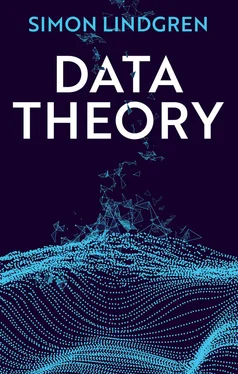In the twentieth century, the study of the social and the cultural relied on two types of data: ‘surface data’ about lots of people and ‘deep data’ about the few individuals or small groups. The first approach was used in all disciplines that adapted quantitative methods. The relevant fields include quantitative schools of sociology, economics, political science, communication studies, and marketing research. The second approach was used in humanities fields such as literary studies, art history, film studies, and history. It was also used in qualitative schools in psychology, sociology, anthropology, and ethnography. […] In between these two methodologies of surface data and deep data were statistics and the concept of sampling. By carefully choosing her sample, a researcher could expand certain types of data about the few into the knowledge about the many. […] The rise of social media, along with new computational tools that can process massive amounts of data, makes possible a fundamentally new approach to the study of human beings and society. We no longer have to choose between data size and data depth.
(Manovich, 2012, pp. 461–3)
Going back to 1978 and Glaser’s book on Theoretical Sensitivity , we can find some useful pointers on how to see the research process – beyond ‘quantitative’ and ‘qualitative’. The first step, for Glaser (1978, p. 3), is ‘to enter the research setting with as few predetermined ideas as possible’, to ‘remain open to what is actually happening’. The goal is then to alternate between having an open mind – working inductively, allowing an understanding of the research object to emerge gradually – and testing the emerging ideas as one goes along – working deductively trying to verify or falsify the developing interpretations. So, we can, quite mindlessly, beat on the piñata for a little while to see what jumps out. Then try to make sense of the things that emerged, and then beat some more to see what the new stuff that is popping out adds or removes from our present analysis.
Using Glaser’s approach, then, means being truly data-driven. He argues that the overarching question that must continually be posed in any research is: ‘What is this data a study of?’ (Glaser, 1978, p. 57). Most of the time, research projects start off with a clear idea of what to study. It would not make sense to be completely oblivious as to the aims of one’s work. But still, Glaser argues, constantly repeating and renewing the question of what the data is actually about, allows for any other ideas or findings to either take place alongside the initially intended ones, or even replace them completely. The point of the question is that it ‘continually reminds the researcher that his original intents on what he thought he was going to study just might not be; and in our experience it usually is not’ (Glaser, 1978, p. 57). The other important question for empirical research is: ‘What is actually happening in the data?’ The flexibility and inductiveness of the approach wants to get at ‘what is actually going on’ in the area that is studied (Glaser and Strauss, 1967, p. 239).
My point here is that being data-driven, as is often the case when working with big data, is not (only) a new ill, caused by the datafication of society and the fascination with huge datasets. Used in the right way, a data-driven approach – a data piñata – can be truly useful in getting to know more about what goes on, what social and cultural processes may be at work, in contexts and behaviours that are still largely unknown to us. From that perspective, not really knowing what we are looking for, and why, can be a means to tread new ground, veering off the well-trodden paths, to get lost to find our way. If we don’t even know what is going on, maybe beating that piñata with a stick isn’t such a bad idea? The new data science opportunities and tools, in combination with social theory has a huge potential to help decode the deeper meanings of society and sociality today.
Breaking things to move forward
Finding good solutions – rather than adhering to rules – should be the end goal of any analytical strategy. This draws on Feyerabend’s idea that anarchism in science, rather than ‘law-and-order science’, is what will help achieve progress. And, as for the risk that such an approach will lead to an unproductive situation where anything goes, we must simply trust in our own ability to think in structured ways even without following rigid rules dogmatically:
There is no need to fear that the diminished concern for law and order in science and society that characterizes an anarchism of this kind will lead to chaos. The human nervous system is too well organized for that.
(Feyerabend, 1975, p. 13)
In order to think creatively and freely in relation to existing approaches, we must allow ourselves not to think so much about which theoretical perspectives have been conventionally agreed to be compatible with one another, or about whether it is officially correct to mix certain methods together or not. In that sense, the approach that I am proposing can be metaphorically understood as a form of hacking. Because, in spite of its popular reputation to the contrary, hacking is not (only) about breaking the law through forms of electronic vandalism. As argued by cryptologist Jon Erickson (2008), hacking can in fact even be more about adhering to rules than about breaking them. The goal of hacking is to come up with ways of using, or exploiting, the structures and resources that are in operation in any given situation in ways that may be overlooked or unintended. Hacking is about applying existing tools in smart and innovative ways to solve problems. Erickson writes that:
hacked solutions follow the rules of the system, but they use those rules in counterintuitive ways. This gives hackers their edge, allowing them to solve problems in ways unimaginable for those confined to conventional thinking and methodologies.
(Erickson, 2008, p. 16)
Datafication presents us with a new data environment – with data traces, data fragments, and unsolicited data – that offers the opportunity to think in new ways about research in the ‘spirit of hacking’, aiming to surmount ‘conventional boundaries and restrictions’ for the goal of ‘better understanding the world’ (Erickson, 2008, pp. 16–18). What I describe here as anarchistic, and as hacking, may sound radical and dangerous – or maybe just plain stupid. But as a matter of fact, this approach is not very far from how science, as conceived by Bruno Latour, in general comes into being. Science and research happen in action. They are not ready made. Interest should not be focused on any alleged intrinsic qualities of approaches, but on the transformations that they undergo in their practical use. Methods do not have any ‘special qualities’, as their effects come from the many ways through which they are ‘gathered, combined, tied together, and sent back’ (Latour, 1987, p. 258). Thus, ‘we are never confronted with science, technology and society, but with a gamut of weaker and stronger associations’ (Latour, 1987, p. 259). Knowledge about society is produced through more or less messy sets of practical contingencies.
It is a common conviction in social research that one cannot do ‘qualitative’ and ‘quantitative’ in the same breath, as they are based on different epistemologies. But this can in fact be debated. As argued by Bryman (1984), the difference may in practice lie not so much in different philosophical views on how knowledge about social reality is achieved, but simply in the path-dependent choices that are made by individual researchers who get stuck with one paradigm or the other. While it has become an eternal truth, reiterated by researchers and methods teachers alike, that ‘the problem under investigation properly dictates the methods of investigation’ (Trow, 1957, p. 33), very few adhere to this in practice. Bryman explains that:
Читать дальше












